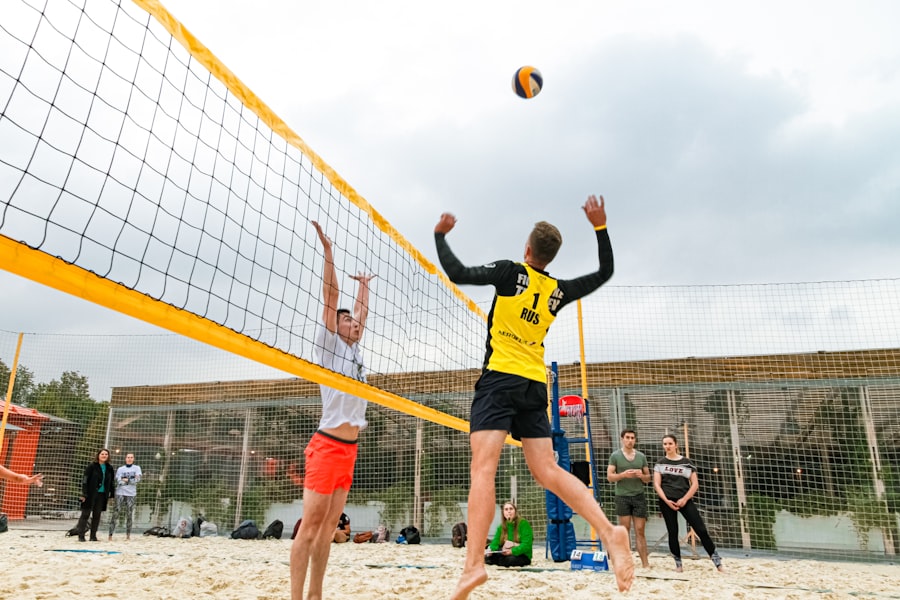Download links
How to install Mastering Volleyball: Tips for Success on the Court APK?
1. Tap the downloaded Mastering Volleyball: Tips for Success on the Court APK file.
2. Touch install.
3. Follow the steps on the screen.
Description
Footwork is the foundation of any successful athlete’s performance, particularly in sports that require agility and precision, such as volleyball.
The ability to move quickly and efficiently can make the difference between a successful play and a missed opportunity.
For instance, a player who can swiftly adjust their position to receive a serve is more likely to execute a clean pass, setting the stage for a well-coordinated offensive play. Moreover, effective movement is not solely about speed; it also involves balance and control. Players must learn to shift their weight appropriately and maintain a low center of gravity to enhance stability during dynamic movements.
This is particularly crucial when transitioning from defense to offense. A player who can pivot quickly while maintaining balance can create better angles for both passing and hitting. Drills that focus on lateral movement, quick steps, and explosive jumps can significantly improve a player’s footwork, allowing them to respond more effectively to the fast-paced nature of the game.
Key Takeaways
- Proper footwork and movement are essential in volleyball to maintain balance, agility, and positioning on the court.
- Developing effective serving techniques involves mastering different types of serves such as float serves, jump serves, and topspin serves.
- Mastering the art of passing and setting requires precise hand-eye coordination, communication with teammates, and understanding the trajectory of the ball.
- Strategies for effective hitting and blocking involve timing, reading the opponent’s movements, and positioning at the net.
- Understanding the importance of team communication is crucial for coordinating plays, calling out shots, and maintaining a cohesive team dynamic on the court.
- Mental preparation and game strategy are key components in volleyball, including visualizing plays, staying focused, and adapting to the opponent’s tactics.
Developing Effective Serving Techniques
Serving is one of the most critical skills in volleyball, as it initiates every rally and can set the tone for the entire match. A well-executed serve can put pressure on the opposing team, forcing them into a defensive position right from the start. There are various types of serves, including the underhand serve, overhand serve, jump serve, and float serve, each requiring different techniques and levels of skill.
For example, the jump serve combines power and precision, allowing players to hit the ball at a higher point, making it more challenging for opponents to receive. To develop effective serving techniques, players must focus on their grip, stance, and follow-through. The grip should be firm yet relaxed, allowing for better control over the ball.
The stance should be balanced, with feet shoulder-width apart to provide stability during the serve. Additionally, players should practice their toss; an inconsistent toss can lead to erratic serves. Regular practice sessions that emphasize these elements can help players refine their serving skills, enabling them to deliver powerful and accurate serves consistently.
Mastering the Art of Passing and Setting

Passing and setting are two of the most fundamental skills in volleyball that require precision and teamwork. Passing is often the first touch after a serve or an opponent’s attack, making it crucial for establishing a successful offensive play. A well-executed pass allows the setter to have a clean ball to work with, which is essential for orchestrating an effective attack.
Players must develop a strong platform with their arms and use their legs to generate power while keeping their eyes on the ball. Setting, on the other hand, is an art that requires not only technical skill but also an understanding of the game dynamics. A setter must be able to read the play and anticipate where their teammates will be positioned.
This requires excellent communication with hitters and an awareness of the opposing team’s defense. The technique involves using the fingertips to push the ball upwards with precision while maintaining a stable base. Practicing various setting drills can help players improve their accuracy and timing, ensuring that they can deliver perfect sets under pressure.
Strategies for Effective Hitting and Blocking
| Strategies | Metrics |
|---|---|
| Hitting | Attack percentage |
| Blocking | Block touch percentage |
| Hitting | Kill percentage |
| Blocking | Blocks per set |
Hitting and blocking are two sides of the same coin in volleyball; one is about scoring points while the other is about preventing them. Effective hitting requires a combination of timing, technique, and strategy. A hitter must approach the ball with speed and jump at the right moment to make contact at the highest point possible.
The angle of attack is also crucial; hitters must learn to place their shots strategically to exploit gaps in the opponent’s defense. For instance, hitting cross-court can often catch defenders off guard, while hitting down the line may be more effective against a team that has shifted their defense. Blocking is equally important as it serves as the first line of defense against an opponent’s attack.
A successful block requires anticipation and timing; players must read the hitter’s approach and jump at the right moment to intercept the ball. Effective blocking also involves positioning; players should aim to form a solid wall with their hands above the net while keeping their body aligned with the net. Drills that simulate game situations can help players develop their blocking skills, allowing them to react instinctively during matches.
Understanding the Importance of Team Communication
In volleyball, communication is vital for success on the court.
Effective communication helps ensure that everyone is aware of their roles during each play, reducing confusion and increasing efficiency.
For example, calling for the ball during a play not only indicates possession but also helps prevent collisions between teammates. Moreover, communication extends beyond verbal cues; it includes non-verbal signals such as eye contact and body language. Players should develop a system of signals that convey specific strategies or plays without alerting opponents.
This level of understanding fosters trust among teammates and enhances overall performance. Regular team meetings and practice sessions focused on communication can help build this rapport, allowing players to feel more comfortable expressing themselves on the court.
Mental Preparation and Game Strategy

Visualization Techniques
Visualization techniques are particularly beneficial in building confidence and reducing anxiety during high-stakes moments. By imagining themselves executing successful plays before stepping onto the court, players can mentally rehearse and prepare for different scenarios.
Developing a Game Strategy
In addition to visualization, developing a strategy is essential for navigating different opponents and match situations. Coaches analyze opponents’ strengths and weaknesses, devising tailored strategies that exploit vulnerabilities and maximize their team’s strengths. Players should think critically about their gameplay, adapting their strategies based on real-time observations during matches.
A Multifaceted Approach to Mastering Volleyball
Mastering volleyball requires a multifaceted approach that encompasses technical skills, such as serving techniques, passing, setting, hitting, blocking, communication, and mental preparation. Each element plays a vital role in creating a cohesive team capable of executing complex plays under pressure. By focusing on these areas through dedicated practice and strategic thinking, players can elevate their game and contribute significantly to their team’s success on the court.
If you’re a fan of volleyball, you may also enjoy reading about the popular mobile game Farlight 84. This futuristic battle royale game combines elements of strategy and teamwork, much like the tactics used in volleyball. Check out this article to learn more about the exciting gameplay and unique features of Farlight 84.
FAQs
What is volleyball?
Volleyball is a team sport in which two teams of six players are separated by a net. The objective is to score points by grounding the ball on the opposing team’s court.
What are the basic rules of volleyball?
The basic rules of volleyball include serving the ball over the net, rallying to keep the ball in play, and trying to score points by grounding the ball on the opposing team’s court. Each team is allowed three touches to return the ball over the net.
What are the different types of volleyball games?
There are several variations of volleyball, including indoor volleyball, beach volleyball, and sitting volleyball. Each variation has its own set of rules and playing environment.
What equipment is needed to play volleyball?
The main equipment needed to play volleyball includes a volleyball, a net, and appropriate footwear. Players may also wear knee pads and other protective gear.
What are the health benefits of playing volleyball?
Playing volleyball can improve cardiovascular health, enhance muscle strength and coordination, and promote overall physical fitness. It also provides opportunities for social interaction and teamwork.
What are the key skills needed to play volleyball?
Key skills needed to play volleyball include serving, passing, setting, attacking, blocking, and digging. Players also need good communication and teamwork skills.





